In this article, discover how AI is transforming FP&A roles, skills, and storytelling — and what...
“Numbers have an important story to tell. They rely on you to give them a clear and convincing voice.”
This quote from Stephen Few aptly opened the latest The Digital North American FP&A Circle “FP&A Storytelling: Craft Stories That Influence and Impact”.
Storytelling is often viewed as a creative domain, separate from the hard metrics of FP&A. But this session challenged that divide, revealing how compelling narratives can turn data into action and finance professionals into trusted advisors. Through expert case studies, practical examples, and three interactive polls, the session unpacked how stories, when structured well, can drive strategic alignment, clarity, and better decisions across the business.
Storytelling Lessons for FP&A
Kavita Aggarwal, Senior Director of Finance at Condé Nast, opened her session by framing finance storytelling as a shift from merely explaining variances to actively shaping outcomes. Drawing from her work at Condé Nast, an iconic global media company, home to brands such as Vogue, The New Yorker, Vanity Fair, GQ, and more, she shared how her team moved from reactive firefighting to proactive planning by co-building a rolling forecast model with tech and procurement teams.
Faced with volatile cloud bills and software renewals and no reliable forecasting system, the FP&A team was stuck in spreadsheets, manually piecing things together. That's when Kavita realised:
“Finance can't just report numbers after the fact. We needed a forecast that worked like a story.”
Instead of finance building numbers in isolation, Kavita sat down with tech owners and procurement to co-build our forecast. Together they created a rolling 12-month forecast grounded in real drivers, such as contract terms and renewal timelines.
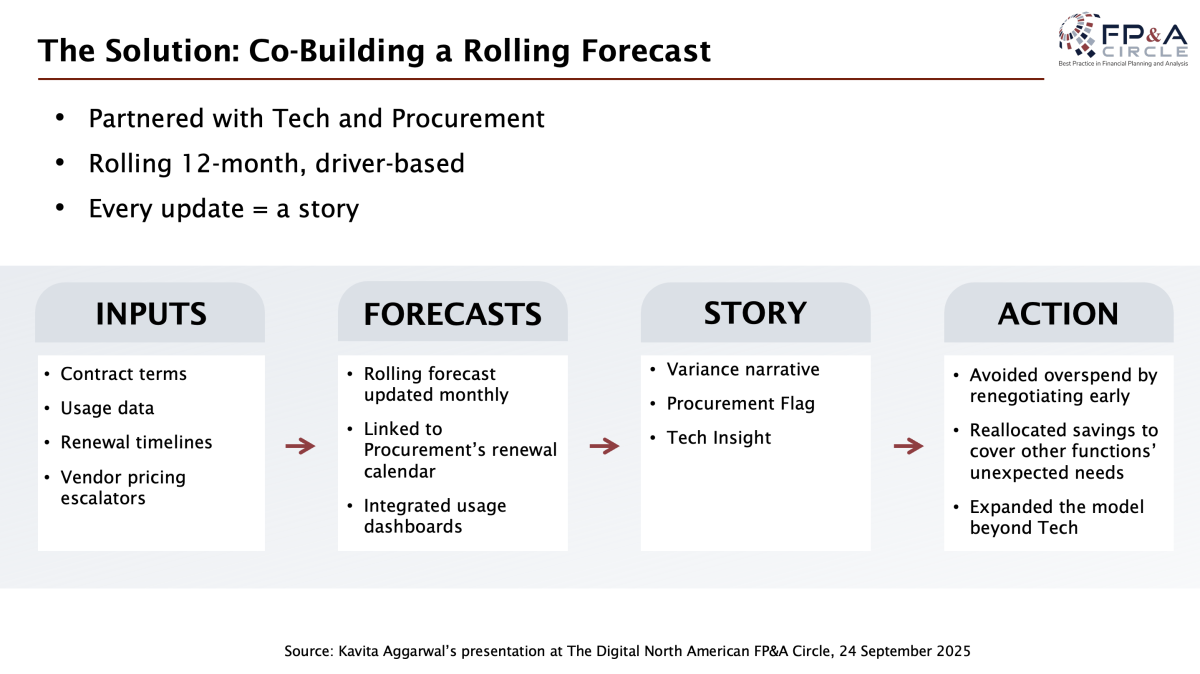
Figure 1
Every update wasn't just a number change; it was a conversation about those changes meant for the business. What truly set it apart was the narrative layer. Each forecast update came with a short story: what changed, why it mattered, and what actions should follow. For example, a flagged spike in compute usage led to early contract renegotiations and budget savings. Trust in the process grew, and the model soon expanded beyond tech into other functions.
Her closing takeaways:
- Finance storytelling should shape the future, not explain the past.
- Collaboration makes the numbers stronger.
- Drivers make the story real and credible.
- Great forecasts spark action and don't just sit on a deck: they change what happens next, catching risk early.
Her final remark stuck with the audience:
“Forecasts are stories that can save your budget.”
Poll Insight: How Often Do You Consciously Apply Storytelling in FP&A Presentations?
The overwhelming majority indicated they already incorporate storytelling to some extent (Always – 36%; Often – 30%; Sometimes – 33%), and only 2% stated never.
As Kavita noted, commenting on the poll results, “How else would you explain the numbers if you don’t have a story behind them?”
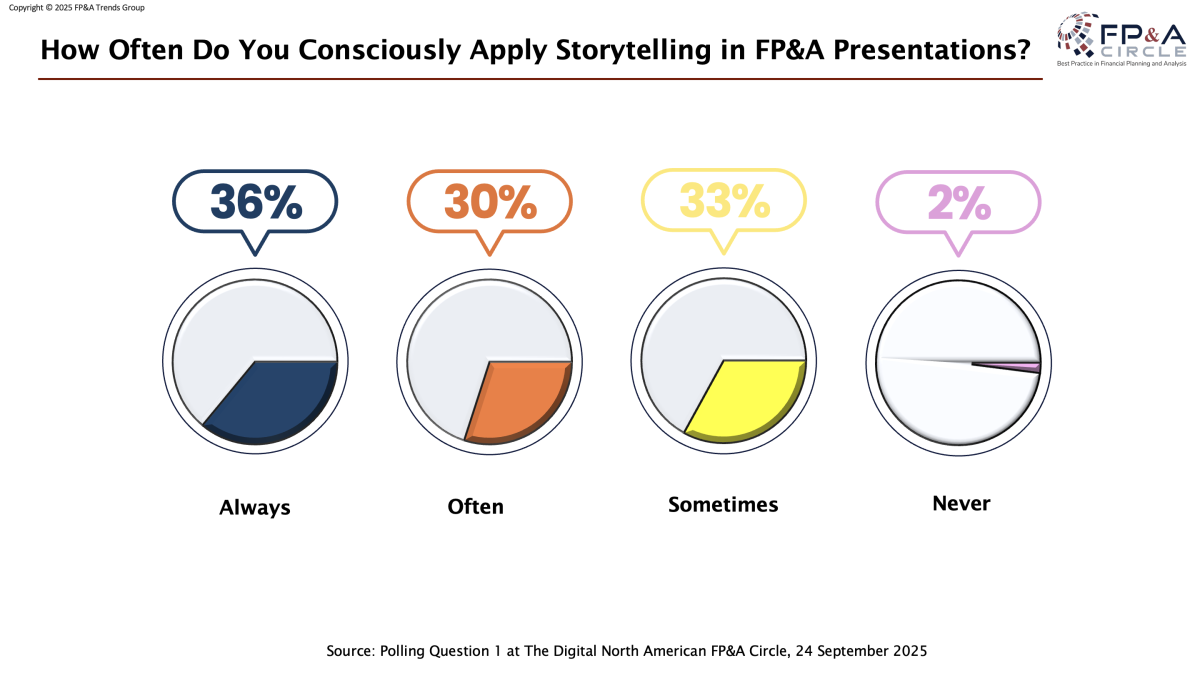
Figure 2
Simple Storytelling with Waterfall Charts
Renata Berbert, Director of FP&A at Amerit Fleet Solutions, focused on translating complex financial insights into clear, intuitive stories, especially for audiences with limited financial literacy. At Amerit Fleet Solutions, an industry leader in providing preventive maintenance and service repair for commercial fleets, she works closely with 60 regional fleet managers who are experts in operations but often struggle with financial presentations and financial reports, because most of the time, they are not familiar with these concepts.
Her tool of choice? The waterfall chart. It can be such a powerful yet simple tool to present financial outcomes, especially to explain variance and plan. Using an illustrative operating profit variance example, she showed how to connect operational metrics such as 12 unfilled positions or 30% excess overtime to financial impact step by step. The visual clarity helped leaders see cause and effect, sparking better engagement and decision-making.
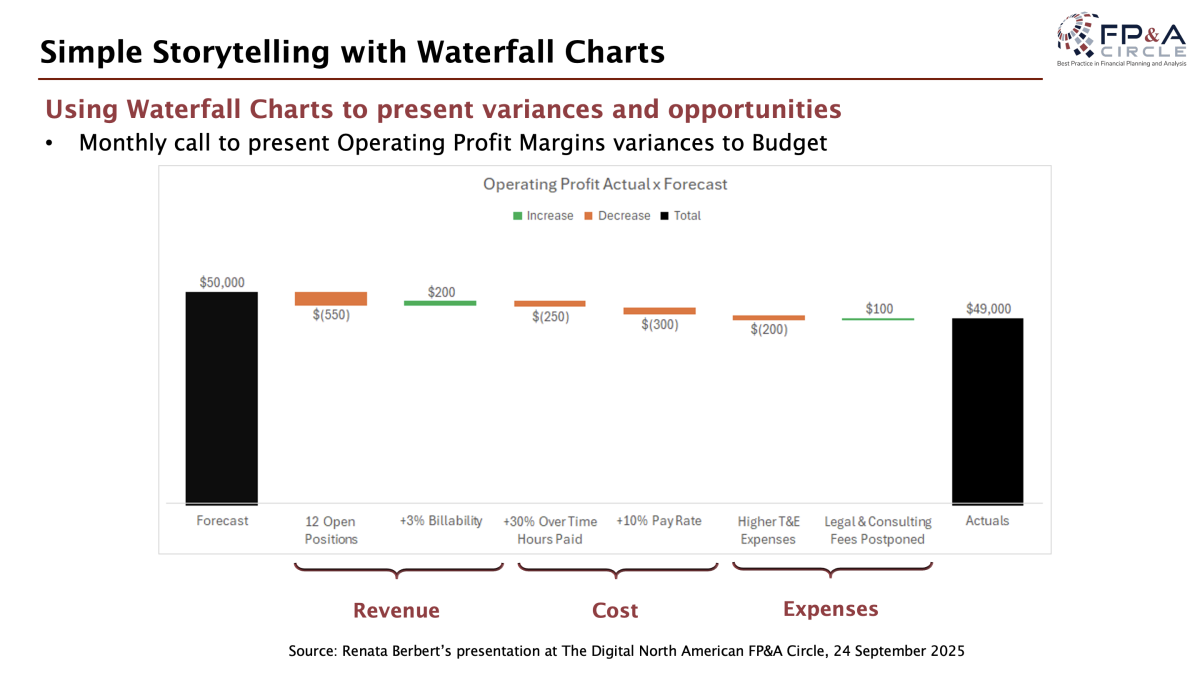
Figure 3
Renata concludes her presentation by saying that simple storytelling, like waterfall charts, can help the FP&A function be the voice behind the numbers. Because it helps eliminate distractions, drives meaningful outcomes, enables faster and better decisions and helps shift mindsets. When we connect operational metrics and financial results, we make ourselves a partner of the function, and everyone can be held accountable for the financial results.
Poll Insight: What is Your Biggest Challenge in FP&A Storytelling?
The majority of the audience 37% selected structuring the story as the biggest challenge, while another 30% picked engaging the audience, and another 26% voted for simplifying complex topics. Сhoosing visuals seemed challenging to only 7%
The results didn’t surprise Renata, emphasising the need for a deeper business context:
“If we’re still behind our Excel sheets, we lack the story. We need to get closer to the business to truly structure it well.”
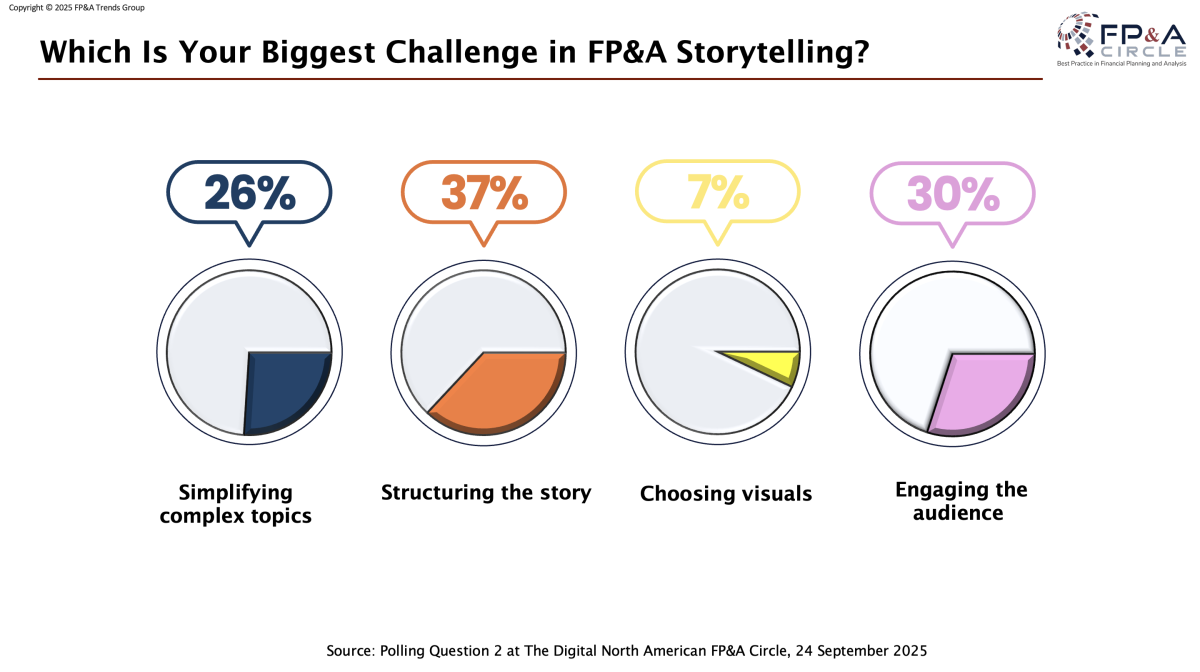
Figure 4
Storytelling - Superpower of Finance Professionals
Anna Zdanowska, Commercial Finance Director at Ecolab, began her presentation with conviction:
“Storytelling is a superpower for us people of finance.”
But beyond that bold statement, she took the audience on a reflective journey — challenging assumptions around the perceived value of storytelling in finance and urging a mindset shift across the profession.
Her curiosity led her to explore how storytelling is viewed more broadly. Turning to AI tools like ChatGPT and Co-Pilot, she asked what skills are considered essential for FP&A professionals. While storytelling and communication consistently appeared in the top ranks, Anna noticed a disconnect: despite being on the list, storytelling was still widely treated as a “nice-to-have,” a soft skill, rather than a foundational requirement.
She strongly disagrees with that view. She said,
“Imagine hiring someone for finance who isn’t proficient in Excel. “For me, storytelling should be treated the same way. It’s not optional.”
However, reality paints a different picture: Anna cited surveys showing that only around 30% of finance professionals feel confident in their storytelling abilities, leaving a 70% skills gap. Even more tellingly, 76% of CFOs believe finance teams need to improve their storytelling capabilities.
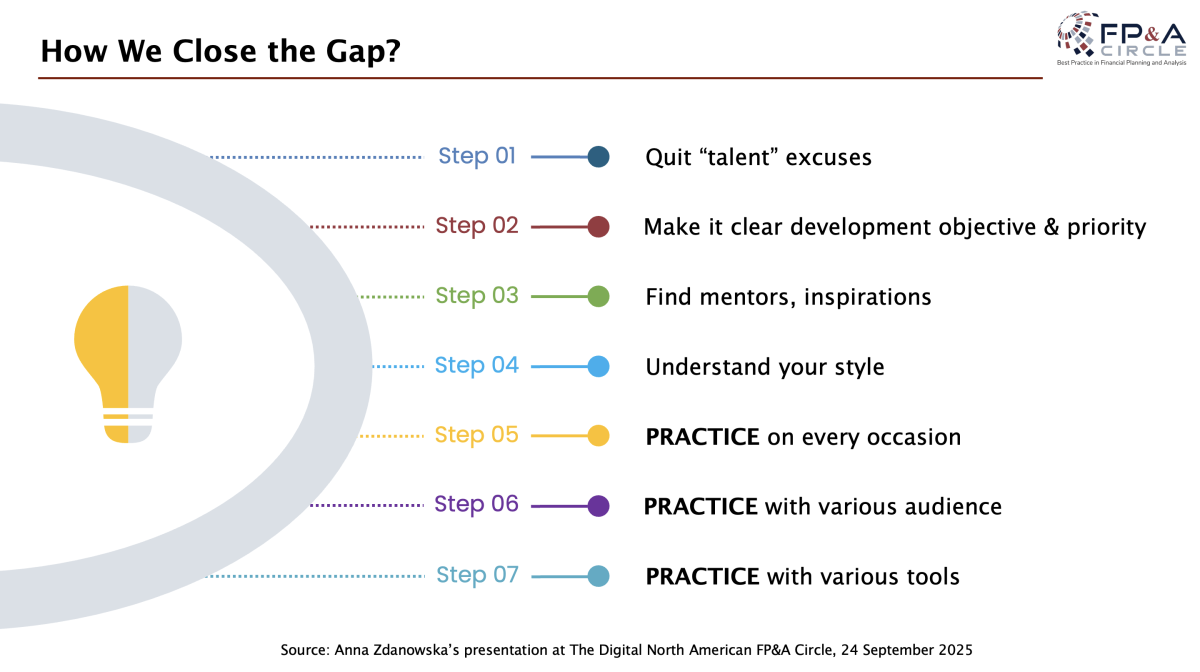
Figure 5
To help close this gap, Anna shared seven personal and practical recommendations:
- Quit “talent” excuses. Storytelling is a skill, not an innate gift. Like another tool, it can be learned and improved. “It’s just a matter of mindset,” she said.
- Make the development objective and priority clear. Although harder to measure than technical skills, setting goals, like the number of speaking opportunities or reports shared, can help track progress.
- Find mentors, inspirations. Learn from storytellers you admire, but don’t try to copy them.
- Understand your style. “Make it yours,” she advised. For Anna, speaking loudly and energetically, once seen as a flaw, became a strength in large settings.
- PRACTICE on every occasion. From formal presentations to casual chats with colleagues or even family members, storytelling is something that improves with consistent use and varied audiences.
- PRACTICE with various audiences. Practice adjusting your language, whether you are talking with finance people or salespeople, and try to get different types of audiences as well.
- PRACTICE with various tools. Storytelling doesn’t have to mean slides. A short Teams message or a well-written email can carry a powerful narrative. “Adapt to the context,” she encouraged.
Anna’s message was both motivational and pragmatic. With intention, support, and practice, any finance professional can become a better storyteller. She concluded:
“If you decide you want to improve your storytelling, you will.”
Poll Insight: Which Area will You Focus on Improving After this Session?
The leading response, chosen by 36% of attendees, was narrative building skills. Close behind, 30% of respondents selected linking analysis to strategy. Audience engagement techniques were the focus for 24% of participants, while data visualisation tools and software attracted 10%.
Reacting to the results, Anna Zdanowska expressed mild surprise that strategic linkage didn’t top the list, but acknowledged that narrative and engagement are equally critical foundations for impactful FP&A storytelling.
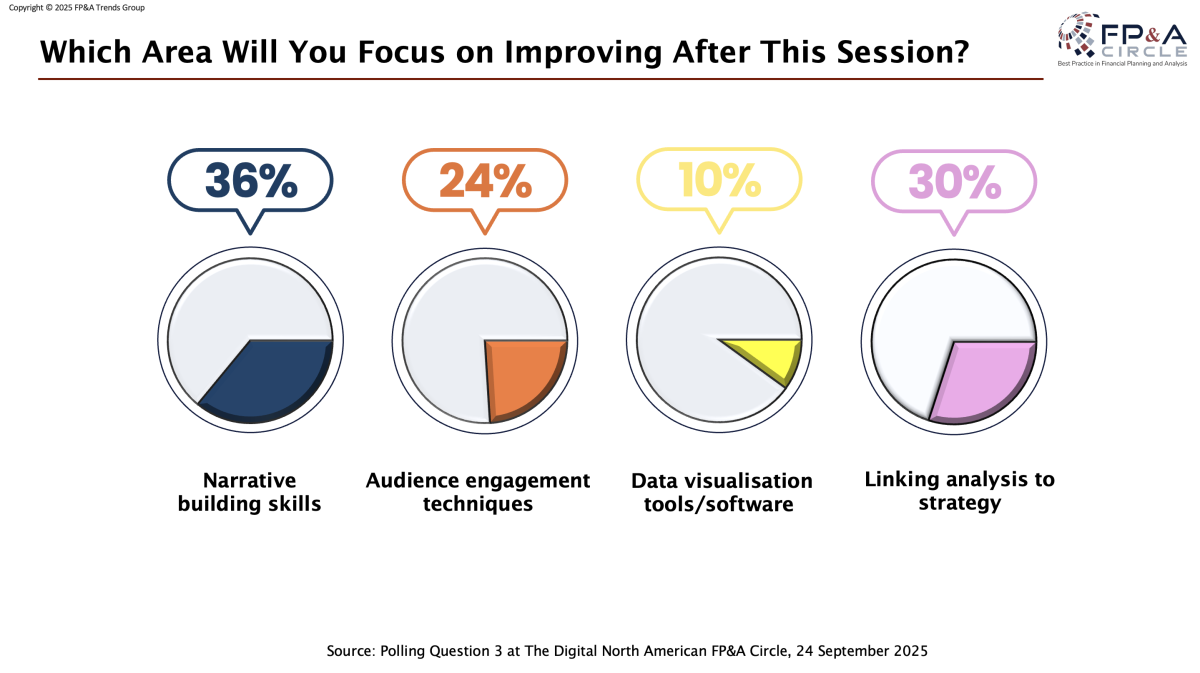
Figure 6
The Role of Technology in FP&A Storytelling
Dominic Nguyen, FP&A Technology Advisor at Wolters Kluwer CCH® Tagetik, brought a personal and practical perspective to the art of storytelling in FP&A, describing it as both a structure and an art. Reflecting on his own evolution from a nervous student to presenting onstage at Gartner, Dominic highlighted how confidence in storytelling can be built over time by following a clear framework and embracing the creative side of communication.
His session focused on several foundational techniques. First, he stressed the importance of knowing your audience, whether by researching them in advance or adapting content to their roles. A CFO, for instance, will want strategic clarity, not operational detail. Dominic advised FP&A professionals to shape their stories based on those needs, using relatable characters, personal anecdotes, and real-world case studies to add emotional appeal and relevance.
He also emphasised the value of simplicity: keep agendas concise, presentations focused, and visuals clean. Dominic said:
“A lot of presentations fail because they include too much detail. It’s hard for the audience to take anything away.”
He recommended limiting key takeaways to three points, delivered at a pace that allows for reflection and connection.
Dominic closed with two essential reminders. First, a strong opening: one that builds rapport by connecting with the company, location, or shared goals, can create instant engagement. Second, being memorable matters. In a world where decision-makers sit through multiple presentations, it's the human connection, clarity, and emotional resonance that make a message stick. “Two weeks later,” he noted, “they’ll only remember the presentation that made an impression.”
Conclusion
This session made it clear that storytelling isn’t a soft skill but a strategic one. Whether through rolling forecasts or waterfall charts, the speakers showed that finance professionals who craft narratives with clarity, context, and collaboration can influence decisions before they’re made.
Great storytelling doesn’t rely on talent alone; it’s a skill built through practice, feedback, and continuous refinement. As FP&A evolves into a more strategic function, the ability to communicate insights clearly and memorably will be more and more essential.
To watch the full webinar recording, please check out this link.
We especially thank Wolters Kluwer, our sponsor, and all the speakers for their insights and leadership on the future of FP&A.
Subscribe to
FP&A Trends Digest

We will regularly update you on the latest trends and developments in FP&A. Take the opportunity to have articles written by finance thought leaders delivered directly to your inbox; watch compelling webinars; connect with like-minded professionals; and become a part of our global community.







